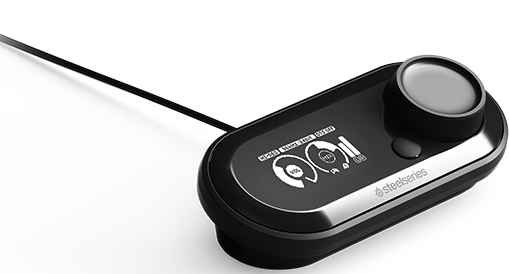SteelSeries Arctis 2018 Lineup: Subtle Changes to Stellar Headsets
The SteelSeries Arctis refresh is incredibly subtle, but the stand-alone GameDAC may appeal to audiophile gamers.

The SteelSeries Arctis line is, on the whole, probably the best collection of gaming headsets on the market today. There's something delightfully simple and straightforward about the Arctis models, from their sleek black chasses, to their solid audio quality, to their perfect-fit elastic headbands.
When I heard that SteelSeries was refreshing its whole Arctis line — the $70 analog Arctis 3, the $100 USB Arctis 5 and the $150 wireless Arctis 7 — I wasn't sure what they could do to make the headsets any better. Or, at least, I couldn't think of anything that the company could fix with a refresh rather than a more comprehensive redesign.
Having now spent some time with all three refreshed models as well as the stand-alone GameDAC (now available by itself for the first time), I can say that most of the changes are so small that I would not have even noticed them if SteelSeries had not pointed them out specifically. But the new changes are by no means unwelcome, and the stand-alone GameDAC might be worth a look from audiophiles who want to combine gaming functionality and more nuanced sound.
GameDAC
Easily the most interesting part of the Arctis refresh is the stand-alone GameDAC. This headset amp initially came with the SteelSeries Arctis Pro + GameDAC package, which cost $250 and earned 4 out of 5 stars and an Editors' Choice award on Tom's Guide. By itself, the GameDAC costs a hefty $130 and works with any headset that has a 3.5-millimeter audio connection.

For those who aren't hip to the audio scene, a DAC is a "digital-to-analog converter." You plug the DAC into a digital system, like a PC or PS4. Then, you plug an analog headset, like a SteelSeries Arctis 3, into the DAC. Using the GameDAC as a go-between, you can now treat an analog headset like a digital one. In other words, you can give it surround sound, change equalization profiles, control chat volume and even control your headset's illumination (provided you have a compatible SteelSeries model, anyway).
My colleague Mike Andronico discussed the GameDAC extensively in his Arctis Pro review, and all of his points still stand. You can get exceptional audio as long as you're willing to do a little tweaking, but the cables are still a bit too short for living room setups.

On the other hand, the Arctis Pro headset is designed specifically with the GameDAC in mind. I used it with the SteelSeries Arctis 3 and found that the difference was much less striking. Yes, it was cool to activate digital surround sound and play around with different equalization levels, but nothing changed the fundamental sound quality very much. The Arctis 3 sounded pretty much like itself, no matter which settings I activated.
Sign up to get the BEST of Tom's Guide direct to your inbox.
Get instant access to breaking news, the hottest reviews, great deals and helpful tips.
MORE: The Best Headsets for Immersive Gaming
If ChatMix is a pivotal part of your gaming experience, and your headset doesn't offer it by default, the GameDAC could be very useful for that purpose. Otherwise, it can't enhance overall audio quality — just which parts of the soundscape you want to emphasize. For me, it'd be a tough sell at $130 by itself — but if you already have an analog gaming headset you like and want digital features on it, it's cheaper than buying an Arctis Pro.
Arctis 3
Of the three headsets, the Arctis 3 has undergone the smallest changes. Everything about the headset's sound quality is identical to the other two, and it doesn't have any new connections. Instead, it's got slightly more memory foam in its ear cups.

That's the only difference that I could observe, aside from some new branding on the box indicating that it works with Nintendo Switch. (So does the original, but the headset predates the console.) The Arctis 3 is still good as budget headsets go, but if you can spare the extra $30 for the model with a Bluetooth connection, it's a useful feature.
Arctis 5
The Arctis 5 has a few upgrades over its predecessor, but not many. Like the Arctis 3, the ear cups have a better fit this time around, thanks to additional memory foam. More important, though, the headset also features a better bass profile and more surround-sound options than the original Arctis 5.

In my testing, the soundscape was subtly but noticeably better than before, especially in games like Overwatch, where directional sound plays a big role. But older Arctis 5 models will receive firmware upgrades for the improved bass and surround sound, so there's no real reason to run out and buy another one if you invested in the previous version.
Arctis 7
Of the three headsets, the Arctis 7 has undergone the biggest upgrade. There's more memory foam in the ear cups, just like in the Arctis 3 and 5. You can enjoy better bass and surround sound, like the Arctis 5. (And, like the Arctis 5, Arctis 7 owners can get the same benefits with a firmware upgrade.)

But the physical design of the Arctis 7 has also undergone a slight revision in order to make it closer to the extremely comfortable Arctis Pro. I appreciated the more nuanced soundscapes, which allowed me to enjoy immersive games with epic soundtracks like Pathfinder: Kingmaker. Beyond that, my opinion about the Arctis 7 hasn't changed much; it's still one of the best headsets on the market, especially for $150.
Bottom Line
I'm all for a company making its products better, but I'm ultimately a little confused about the Arctis refresh. The changes to the headsets are so subtle that you might never notice them unless you had both models side by side. And even then, there's no difference in performance, provided you can apply a firmware update or two.
Still, the Arctis line is well beyond reproach, and slightly plusher ear cups don't do anything to change that. The Arctis 3 is still an excellent choice for Switch owners, the 5 is an affordable middle ground for PC aficionados and the 7 is a versatile device with flawless wireless performance. If they weren't on your radar before, they're worth a look — and if you bought one a few years back, you can safely hang on to yours for at least a few more years.
Credit: SteelSeries
Marshall Honorof is a senior editor for Tom's Guide, overseeing the site's coverage of gaming hardware and software. He comes from a science writing background, having studied paleomammalogy, biological anthropology, and the history of science and technology. After hours, you can find him practicing taekwondo or doing deep dives on classic sci-fi.

